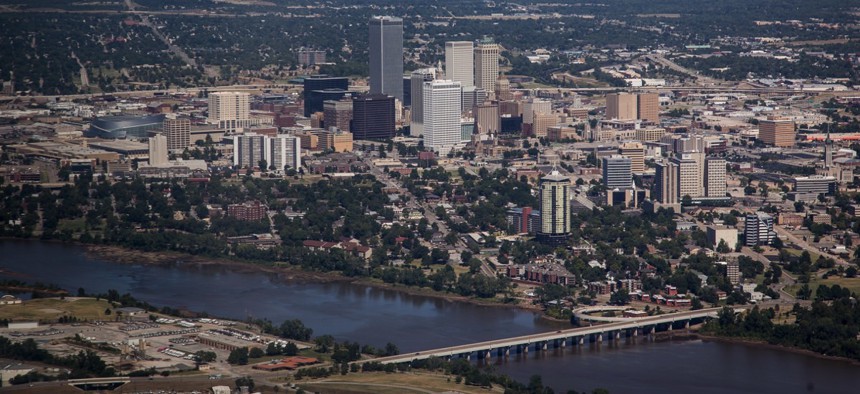Making Tulsa More Resilient Means Wrestling With the City’s Racist Past


Connecting state and local government leaders
Disparities persist long after the largest race-based massacre in U.S. history.
Greenwood Avenue in Tulsa, Oklahoma was known as “Black Wall Street” during segregation because of its many, thriving African-American-owned businesses. Armed, white mobs burned the district to the ground in May 1921, after a 19-year-old black man, Dick Rowland, was accused of assaulting a 17-year-old white girl in an elevator.
Tulsa County dismissed the case against Rowland that September when the girl declined to press charges, but as many as 300 mostly black people were killed, according to American Red Cross estimates. The Tulsa Race Riot remains the largest race-based massacre in U.S. history.
On Tuesday, the city of Tulsa released its first-ever resilience strategy, which is as much about reconciling the city’s past as it is addressing existing racial and ethnic disparities. Most glaring is the life expectancy gap between a few of Tulsa’s northern, predominately African-American ZIP codes and whiter, more affluent ones to the south.
In 2005, what’s known as the Lewin Report found residents in those ZIP codes to the north had a shorter life expectancy by 15 years. A decade later, the gap decreased to 11 years and now sits at 10.7 years.
A number of social determinants play into the health disparities including access to medical care, grocery stores, mental health treatment and safe and affordable housing. The city’s Resilient Tulsa strategy has proposed 41 actions addressing improved health outcomes, as well as racial equity, economic inequality and disaster preparedness.
The Rockefeller Foundation selected Tulsa to be one of its 100 Resilient Cities under the previous Mayor Dewey Bartlett Jr., but current Mayor G.T. Bynum shifted the resilience strategy’s focus to inclusion and equity—the reason he ran against Bartlett in the first place.
Bynum then hired DeVon Douglass away from the Oklahoma Policy Institute in July to serve as Tulsa’s chief resilience officer. She quickly recognized more public education around racial equity was necessary.
“Especially as a woman of color, it can feel like surely everyone knows that this is a problem in our city—the life expectancy gap, the higher arrest rates for people of color, the higher unemployment of people of color,” Douglass told Route Fifty in an interview. “[Resilient Tulsa is about] educating people who don’t know the problems that Tulsans are facing and then providing the infrastructure for them to get involved.”
Tulsans want to get involved once they understand there’s a problem, she added.
Action 13 of the strategy involves forming a healthy food environment coalition for reconsidering land-use policies and rezoning to foster urban agriculture. The coalition will also promote the federal Supplemental Nutrition Assistance Program and Woman, Infants and Children program to maximize use.
Resilient Tulsa’s Action 14 aims to improve the LGBTQ+ community's access to Federally Qualified Health Centers and free clinics.
Then there’s Action 15 to expand the Educare Family Health Project, an early childhood education program focused on nutrition and health literacy and physical fitness.
Each action comes with a set of public-private partners, many of which Tulsa identified during the 100RC application process. The city missed the first round, so it strengthened its credentials by recruiting stakeholders like the Tulsa Police Department, Tulsa 1921 Race Riot Commission, Workforce Tulsa, the Zarrow Family Foundations and the Tulsa Community Foundations.
Tulsa also teamed with 100RC platform partners Hustle, a mass-texting tool which will be used to communicate race-reconciliation conversations and other citywide events to residents, and the St. Bernard Project, a disaster relief nonprofit that will help small businesses better prepare for disruptions from severe weather.
The first order of business is launching the Mayor’s Office of Resilience and Equity on July 1, along with racial-reconciliation dinners with the faith community and 918 Day celebrating Tulsan diversity all this quarter. There are also plans for a teacher appreciation initiative and hiring a housing policy director. Douglass will soon have three resilience experts working under her.
“I think it’s a very positive trend, in terms of what we’re seeing in our network; there was a tendency in the past to silo equity,” said Otis Rolley, 100RC North America managing director. “As we’re advancing the resilience work, the equity lens is really showing itself to achieve systemic change.”
No longer are cities like Tulsa simply hiring chief equity officers to check a box, he added.
Tulsa’s resilience strategy comes shortly after the city released its Equality Indicators, scoring a 38.93 out of 100.
City Hall is coming off its largest economic development capital improvements program to date, Vision Tulsa, the New Tulsans Initiative for including the immigrant community, and the creation of an Office of Performance Strategy and Innovation.
“Tulsa has made great strides in the last few years in acknowledging the disparities that exist in our community, but acknowledgment is not enough,” Bynum said in the announcement. “The Resilient Tulsa strategy is a plan of action for building a city where every person has an equal shot at a great life.”
Dave Nyczepir is a News Editor at Government Executive’s Route Fifty and is based in Washington, D.C.

NEXT STORY: Keeping Students' Data Safe





